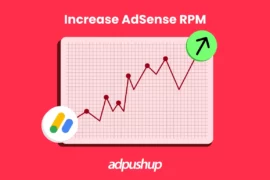Have you been trying to figure out how to calculate click through rate? This blog takes you through the ins and outs of click through rate and how you can take it up a notch.
In the online world, CTR (click through rate) matters a lot, not only for advertisers but also for publishers. Therefore, it becomes imperative for both to know how to calculate click through rate and to be well-versed in all its nitty-gritty.
The primary role of an advertiser is to create an ad or copy that can get a higher CTR. Similarly, publishers need to place these ads in a way that generates the highest CTR for them.
From a publisher’s viewpoint, click-through rate is one of those essential factors that help them generate money and retain advertisers. If you somehow fail to give adequate clicks, your advertisers are likely to flee. Therefore, it is important to understand what it exactly is.
We have curated this blog to give publishers a clear idea about the same and how they can improve their CTR.
Before jumping straight into how to calculate click through rate, let’s understand exactly what it is.
What is Click Through Rate?
A click through rate is the relationship between impressions and clicks: out of the number of times your ad or search result is shown to a visitor, how often users click it.
Basically, click through rate is the number of times an ad is clicked divided by the number of times the page or ad unit is viewed. Here is how it’s calculated.
Click Through Rate vs Conversion Rate
Both click-through rates and conversion rates share many differences. Outlines below are the major differences between these two. Have a look.
| Metric | Calculation | Focus | Goals |
| CTR | Total clicks / Total impressions x 100% | Effectiveness of an ad in attracting clicks. | Attract more clicks and generate more traffic. |
| Conversion Rate | Total conversions / Total visitors x 100% | Effectiveness of a website or landing page in generating leads or sales. | Improve the likelihood of visitors taking a specific action. |
Furthermore, here are a few more differences between both metrics.
Generally, the click-through rate is considered in the top-of-the-funnel metric. On the other hand, the conversion rate is considered further down the funnel, usually to measure what percentage of people end up buying the product/service, or other specific actions.
Next, CTR is used by marketers as a key performance indicator, while the conversion rate is used to measure the effectiveness of a website or a landing page.
Although improving your click-through rate can help increase the traffic, but not necessarily sales or leads, whereas improving the conversion rate can lead to higher revenue and profits.
In the end, both of the metrics should be analyzed in context with other related metrics and your business goals. It will allow you to make informed decisions and elevate your optimization efforts.
CTR for PPC Vs. Organic Search
We calculate CTR the same way for all marketing channels, yet we end up with varying CTR.
A click-through rate derived from organic marketing, such as SEO, will tell you more about where exactly your website ranks in the SERP (Search Engine Result Page). Your CTR here will be the number of people who will click on your website through SERP.
Talking about PPC on the other hand, CTR here depends on various other factors such as your target audience, your platform of advertising, and your ad’s message.

How is Click Through Rate Calculated?
CTR = No. of clicks / No. of exposures
CTR% = No. of clicks * 100 / No. of exposures
So, for instance, an advertisement on your website is viewed by 100 people. If 5 of them click on the ad, your CTR would be 5 percent. Now, looking at the same with PPC Model, the higher the CTR percentage is, the better earnings your website will generate for you.
Now that you know how to calculate click through rate, you must be wondering what a good CTR is. Let’s find out.
Also Read – How to Increase Ad CTR (Clickthrough rate)?
Click through rate calculator
Why Should You Calculate Click Through Rate?
Click-through-rate is the most important and heavily weighted part of the quality score. What is the first thing Google looks to while trying to get the feedback of users on advertising text? The answer is CTR!
If a particular ad has a higher click-through-rate, it means that the majority of the users find it useful and relevant to what they are searching for. Relevancy is the second most important component.
Google considers the relevancy of your keyword to an advertisement. Similarly, Google uses CTR to understand the relevancy of an advertisement to your website and maintains a quality profile for your website.
Sites with very low CTR, could be considered poor in terms of quality (exceptions being there) while the sites with very high CTR, are suspected of activities against google’s policies and have to go through automated and manual reviews.
Why is it Difficult to Compare CTR?
You must be wondering if you can compare your CTR with other blogs or if you can calculate their click through rate. Unless you know the blogger personally, there is no benchmarking tool to do that for you. Even the Adsense Scorecard, which google calls a benchmarking tool, does not really compare you with your peers in terms of CTR.
Comparing CTR, and a number of other Adsense statistics, is difficult because every website/blog is incredibly different.
A comparison might even be pointless at times.
Why? Because the number of people who click on an advertisement varies tremendously, depending on a number of factors. Outlined below are some of the factors that play an important role in deciding your click through rate.
What are The Factors Affecting Publishers’ CTR?
There are a whole heap of factors that can end up affecting CTR moving ahead at a good clip. Following are some of them.
1. Niche
Surprisingly, CTR varies widely for different websites/blogs, even if your blogs have every other factor controlled.
The simplest reason that comes to mind is the topic of the blog.
For instance, many publishers believe that websites with products related topics appear to get higher click-through-rate than other sites.
According to them, people tend to click on ads more when they are in buying mode. When users see an ad that is about a relevant product, they are much more likely to click on the advertisement.
2. Seasonality
CTR, as well as CPC, can, in fact, vary seasonally. The Adsense team has mentioned this on its support page.
For instance, there are countless blogs out there that claim to have higher CTR on weekends. While some have pretty low impressions throughout the holidays and feel that the holiday season can result in huge variations in CTR.
3. Relevant Ads
Let’s understand this one with an example. Say, you have a blog about ballpoint pens. Which ads do you think to have more probability of being clicked – ballpoint pen ads or dog food ads?
Of course, your visitors are interested in ballpoints and are more likely to click on ads relevant to the same. In almost all cases, the more relevant the advertisements are to the subject/niche of your blog, the more likely they are to get clicked.
While there could be a few blogs with topics that are difficult for Google to distinguish, Adsense is generally quite good at differentiating. They have ads for almost all verticals and niches. There have also been a few cases where bloggers have contacted Google about irrelevant ads, and Google has made changes to fix the problem.
4. Visitor’s Profile
It has been repeatedly reported that websites and blogs with higher levels of repeat (loyal) readers have lower click-through-rate as compared to the ones that have high search engine traffic.
The only logical reason for this problem is that your loyal readers become blind to not only your website design but also the ad positioning, which is why continuous Ad optimization is needed for a website to maintain a higher CTR.
Search-Engine visitors, on the other hand, are mostly looking for specific information and are more likely to click the ads on your website or blog, as they are keen on gathering information.
Another group of readers is the one that is referred to your website or blog by another website. Such readers can choose any course of action, depending entirely on what the referrer is all about. However, CTR is low for such readers mostly. Therefore, do not expect too much from referral traffic.
5. Noise Around the Ad unit
There are also many design-related factors that affect the CTR. Publishers need to be careful to not draw extra attention to the ads by creating animated graphics or putting them inside an obtrusively colored box, as this can lead to the banning of their account.
One important technique that does not break any Adsense TOS is to utilize areas around your advertisements to your advantage.
However, stats have shown that advertisements perform far better on a clear, white background and white space around them. Publishers should ideally run tests between different designs to see what works for them.
6. Placement/Location of the advertisements
Another important factor that affects CTR is the design and positioning of the advertisements on your blog or website. For instance, if you put the ads on the very bottom of the page their viewability may decrease, which will result in low CTR.
Therefore, you should always position the ads where they can be seen and clicked easily. The same is the case with the colors you choose for the ads.
Here are some important points that you as publishers need to pay attention to:
- Place ads above the fold.
- Merge them with the content.
- Use wider, instead of longer Ad units.
- Use either a similar or contrasting color theme [Test what works best].
7. Option to ‘click’
Does your blog contain any outbound links other than the Adsense ads? If your answer is NO, there are more chances of your visitors to click on those particular links. Bloggers who are using this technique normally have higher CTR than the pages with outbound links.
Of course, there are a few problems with this technique, since you would not be able to interlink your blog. This will not only make your site insular but also makes search engine optimization difficult. De-clutter your blog for better results!
8. Device Type
Although it’s beyond your purview, the type of device your audience is targeting to use can end up affecting the CTR. As per the study by Web Marketing Pros, compared to PCs, the mobile device generates more clicks.
If you’re running low on budget, you can strategically be targeting the audience, by choosing only users with mobile devices. It’s also important to note that this may not work out in every case.
In fact, in some cases, it has been seen people missing out on many potential clicks. It usually boils down to the type of products/services, the channel of advertising, etc, that you opt for.
Also Read – Ad Targeting: A Publisher’s Guide (with Pros And Cons)
How to Increase your Click Through Rate?
It is clear by now that having good CTR can help in revenue optimization. But before we talk about revenue, it is important to increase CTR. Therefore, outlined below are some tricks you can follow to get desired results.
- Epic Content
This is the most important tip anyone can give you for increasing your click-through-rate. Great content brings more visitors, resulting in more revenue. Rather than creating countless useless sites made just for making some quick bucks, take some time out and build impressive content for your blog.
Writing high-quality will not only help with your click-through-rate, but will also allow you to leverage premium SEO. Moreover, it will allow Google to place targeted ads on your blog for your audience. Having more relevant ads is the only way to lure your visitors to click them and boost your overall earning. - Advertisement Placement
You need to test different placements, positions, and combinations for advertisements on your blog. Avoid putting ads on random positions, since it will have a negative impact on CTR and your earnings. What you should be doing is trying out different colors, types, and sizes of ads in order to see what works best for your website.
Moreover, you need to keep switching the ad positions. Since your loyal readers visit your blog regularly, they start ignoring ads if they are placed in the same position all the time. This is known as banner blindness. Periodic change in the placement of ads is the only way to cope with this problem.
Additionally, you should pay attention to suggestions from Google. While the majority of bloggers ignore them, you should ideally read what they have to say and then test if it’s correct. - Modifying Ads
Always keep experimenting with factors related to ads. Try modifying the advertisement colors to more bright versions rather than standard adsense colors, as visitors get used to them.
Changing the colors frequently to brighter shades allow the ads to stand out from the rest of your blog’s content and will grab the attention of your visitors. Also, you need to make the font of your ads bigger than the content font so that users see them immediately. It will make the ads prominent and increase the chances of clicks. - Remove Unwanted Ads
Do you have a lot of posts or pages? Just remove all those ads from the places that do not convert (use heatmaps!) and have very low CTR. De-clutter your blog. After doing this you’ll see that clicks are no more wasted through unwanted, crappy posts.
- Suitable Keywords
Keywords play a very important role in gaining search engine traffic. Since visitors coming from search engines contribute the most to CTR, it is vital for you to understand the importance of choosing the right keywords.
Now, whether you’re a publisher or an advertiser, it goes without saying how CTR correlates with conversion rate. Take a look.
What is a Good and Safe Adsense CTR?
It can actually range from .05% to a whopping 10% and primarily depends on how much time you are spending to optimize your website for more clicks and what niche the website is about. The average CTR for the display advertising industry is about .10%.
In any case, publishers should keep in mind that getting a high number of clicks on Adsense advertisements will not necessarily guarantee good income.
There are a number of other factors involved. For one thing, you need to target the ads that can drive good pay-per-click. Sometimes a single click earns you more than 100 clicks would do. It all boils down to the eCPM or actual earnings.
Since it is against Adsense terms of service to reveal exact statistics about your account and of course, the CTR, it would not be possible to pepper up the article with real-life examples.
But, the majority of the bloggers have CTR between .50 to 3 percent.
At this rate, not only blog or website earn a decent amount, but it also stays pretty safe. On the other hand, if your ad units get too many clicks and high CTR, your Adsense account can be exposed to certain risks.
That said, in order to maintain an optimal click through rate, it’s vital that you’re well-versed with the factors that affect it. Let’s have a look.
Also read: Google AdSense: Guide to Improve your Existing Revenue
Case Study
The cash you make from Adsense is controlled by quite a number of variables, such as the number of visitors you get to your blog, the amount of money advertisers are paying in your particular niche, and the percentage of visitors that click the advertisement.
Clearly, the more ads pay you, the more users you are getting and the more they are clicking on your ads, the more money you will make.
We have carefully chosen two websites with similar layout. Therefore, neither of the factors is going to have any considerable effect, apart from the possibility of different reactions of visitors to the content. The screenshot from Adsense Interface below shows the CTR of each site.

The very first thing you might notice between the two websites is that they have very different click-through-rates. The first site or site 1 has an average click-through-rate of 23.33 percent, while the other one has an average of 3.95 percent. When you compare the results, the first site is clearly leading in terms of clicks. It gets 6 times more clicks than the second one. This means that we can increase our revenue 6 times if we know what to do, can’t we?
If both these websites have similar layouts, color schemes, and design, what exactly is causing these tremendous differences? The answer is all in the suitable keywords. Site 1 targets a “buyer” keyword, while Site 2 targets an informational keyword. For instance, in the case of the dating niche, Site 1 would be about the finest dating sites you can join, while Site 2 would be about tips and tricks on how to meet the partner of your dreams, etc…
It is possible that the same advertisers are offering the same products. However, Site 1 attracts people who are ready to make buying decisions and all they are looking for is a little help and encouragement.
On the other hand, Site 2 will convert only a few people since most of the visitors will be looking for some free advice or information. You must understand that it is not just the niche in general that has such an incredible effect on adverts; it is the relevance that counts a lot.
Considering the same example of the dating niche, Site 1 offers information on dating sites, so the ads are related to those sites. This shows that the content of the website and the ads are incredibly close. On the other hand, Site 2 might offer general information about dating, meeting people, starting a conversation, etc., but if the ads are promoting dating eBooks and websites, there is very little in common between the Adsense ads and the content of the site.
This affects CTR to a great extent.
Publishers should ideally always test changes before incorporating them. Seeing what works best for your website is the most suitable way for increasing CTR and thereby revenue.
Key Takeaways
- CTR is the relationship between impressions and clicks and is calculated as the number of clicks divided by the number of exposures.
- There is no benchmarking tool for Adsense CTR, and even the Adsense Scorecard does not really compare you with your peers in terms of CTR.
- Adsense is generally quite good at differentiating between verticals and niches, and Google has made changes to fix the problem.
- The design and positioning of the ads on your blog or website can affect the CTR.
We hope by now you have understood how to calculate click-through rate and all its aspects. For more, be sure to check out the frequently asked questions mentioned below.
FAQs
CTR is the number of clicks that your ad receives divided by the number of times your ad is shown. It can be used to gauge how well your keywords and ads, and free listings, are performing.
Your CTR is important because it tells you what works (and doesn’t work) when reaching your target audience. If your CTR is low, you may be targeting the wrong audience or not speaking their language persuasively.
The higher your CTR, the more ad impressions you will receive, the better your organic search ranking, and the greater your conversion rate.

Deepak has a keen eye for detail and a deep understanding of the ad tech landscape. Whether it’s through in-depth articles, thought-provoking insights, or compelling storytelling, he’s dedicated to helping people navigate the complex world of ad tech with the simplicity of his words.







